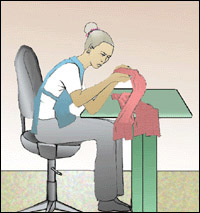Sewing and Related Procedures » Fine Work

Employees often perform fine work or tedious jobs at cutting, sewing, and quality control stations. Many times these jobs have acute visual requirements, coupled with intense wrist, hand, and finger movements. Following are potential risk factors and possible solutions involved in this process.
Potential Hazards

-
Employees use a pinch grip to hold small scissors between the index finger and thumb. Repeated pinch grip may cause hand or wrist injuries (Fig. 1).
-
Holding small scissors between the index finger and thumb also can cause contact stress on the fingers.
-
While holding scissors or manipulating fabric, employees often maintain awkward arm, wrist, hand, and finger posture.
-
Cutting and manipulating fabric requires the employee to use repeated motions.
Possible Solutions

-
Invest in tools designed to promote neutral joint postures and minimize contact stresses (Fig. 2).
-
Use electric, pneumatic, or otherwise partially automated tools to reduce force and repetition of pinch grip (Fig. 2).
-
Use tools and work practices that encourage workers to avoid using more force and movement than the job requires.
-
Use job rotation through tasks that do not require pinch grips.
Potential Hazards

-
Employees hold their neck, trunk, and arms in an awkward position as they strain to see detail in an object (Fig. 3).
-
Insufficient lighting makes it difficult for employees to see their work, and may cause eye fatigue and headache.
Possible Solutions

-
At the workstation, adjustable task lighting must shine on the work area to make it easier for the worker to see the product (Fig 4).
-
Provide adjustable chairs and training on how to properly use them (Fig 4).
-
Provide magnifying glasses at workstations where necessary (Fig 4).

Fig. 5
Height-adjustable table.

-
Use height adjustable tables (Fig. 5) and sit/stand stools (Figs. 6 & 6a) to allow employees to adjust their postures.
-
For close work that is hard to see, the table should be adjusted 2 to 4 inches above elbow height. However, working at this height might mean that workers have to work with their elbows raised, which can make their shoulders and forearms uncomfortable. Raised elbows should be supported with padded elbow rests.
-
-
Institute job rotation.

